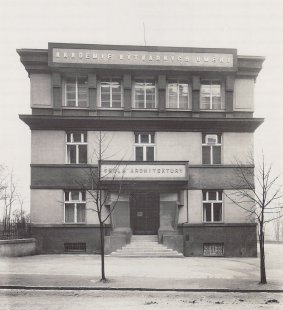
Otakar Novotný: Exhibition of the Imperial Royal Academy of Arts
We were most interested in its architecture department, in the Kotěra school.
Source
Časopis Styl, roč. V (1912), str. 175-176
Časopis Styl, roč. V (1912), str. 175-176
Publisher
Petr Šmídek
24.04.2014 12:55
Petr Šmídek
24.04.2014 12:55
Otakar Novotný
One thing was unexpected and thus striking during a superficial review of the submitted works: almost consistent negation of formalism. Students were to focus on the overall solution to the given tasks, only occasionally on details; the teacher thus chose an analytical approach. Not, however, a historically analytical one, which assumes much maturity and architectural sensitivity – this certainly sounds very paradoxical, especially to compiler philistines, the creators of today’s official architecture – so that it does not remain in the student as an indelible foundation of all superficial eclecticism. The best teaching aid here is the model, which indeed hides the danger of a lack of imagination in graphic representation, yet it is nevertheless a very illustrative demonstrator of compositional flaws. The student is thus faced with a significant task – the advantage is that topics of academic significance are not chosen, but rather those grounded in reality, which are close – that they are working through; with such a method, they will be forced to proceed automatically later on, even independently, in contrast to a system that settles for small tasks, gradually increased. Is it possible to decide whether the analytical or synthetic approach is more advantageous in all circumstances? It is indeed certain, that is the matter of the individuality of the teacher. And as the first method, against the advantage of the naturally rational procedure in solving the task, conceals the danger of formalist helplessness, the second limits the good aspects of honest architectural training too much at times with an overly developed sense of beautiful or interesting form at the expense of the integrity of thought.
There are school works and schoolboy works. Good guidance excludes the second case; nevertheless, the works of the school of Kotěra have their particular significance in the development of Czech architecture, just as last year the school of Plečnik, which did not have exhibitions this year.
The review of any good artistic school generally means a mixture of joy and sadness. That these young people can, under the initiative of their teacher and through mutual learning and comparison, achieve so much that is almost complete, almost no longer school-like, but also how many of these young people can work and stand alone when they are deprived of their leader.
There are school works and schoolboy works. Good guidance excludes the second case; nevertheless, the works of the school of Kotěra have their particular significance in the development of Czech architecture, just as last year the school of Plečnik, which did not have exhibitions this year.
The review of any good artistic school generally means a mixture of joy and sadness. That these young people can, under the initiative of their teacher and through mutual learning and comparison, achieve so much that is almost complete, almost no longer school-like, but also how many of these young people can work and stand alone when they are deprived of their leader.
The English translation is powered by AI tool. Switch to Czech to view the original text source.

1 comment
add comment
Subject
Author
Date
Kotěra učitel
Petr Šmídek
25.04.14 01:52
show all comments












